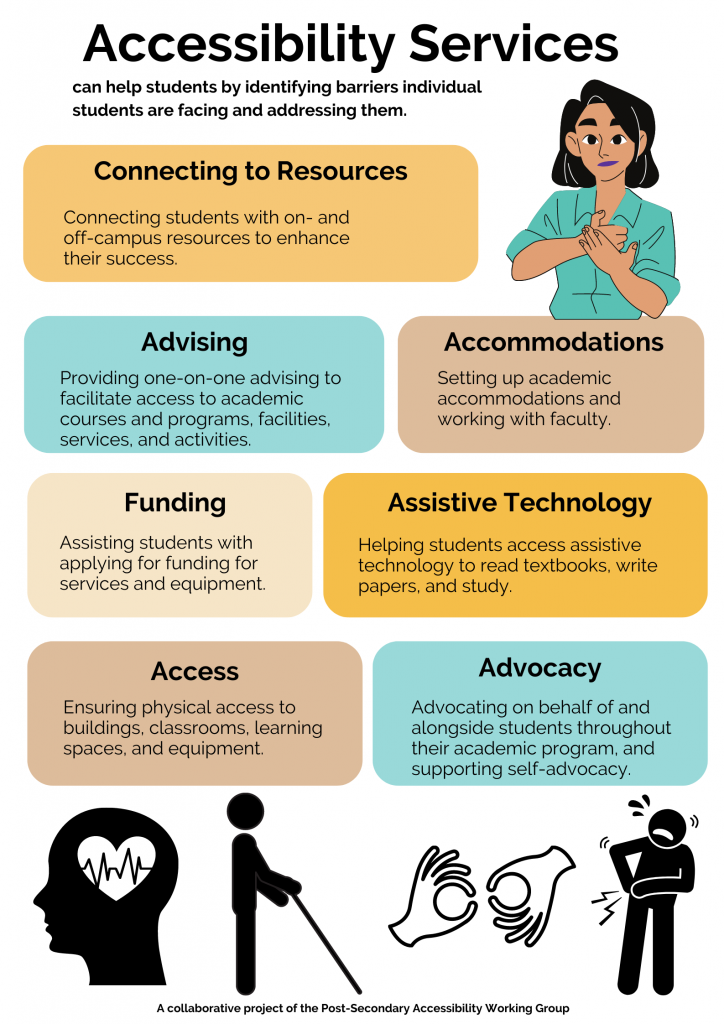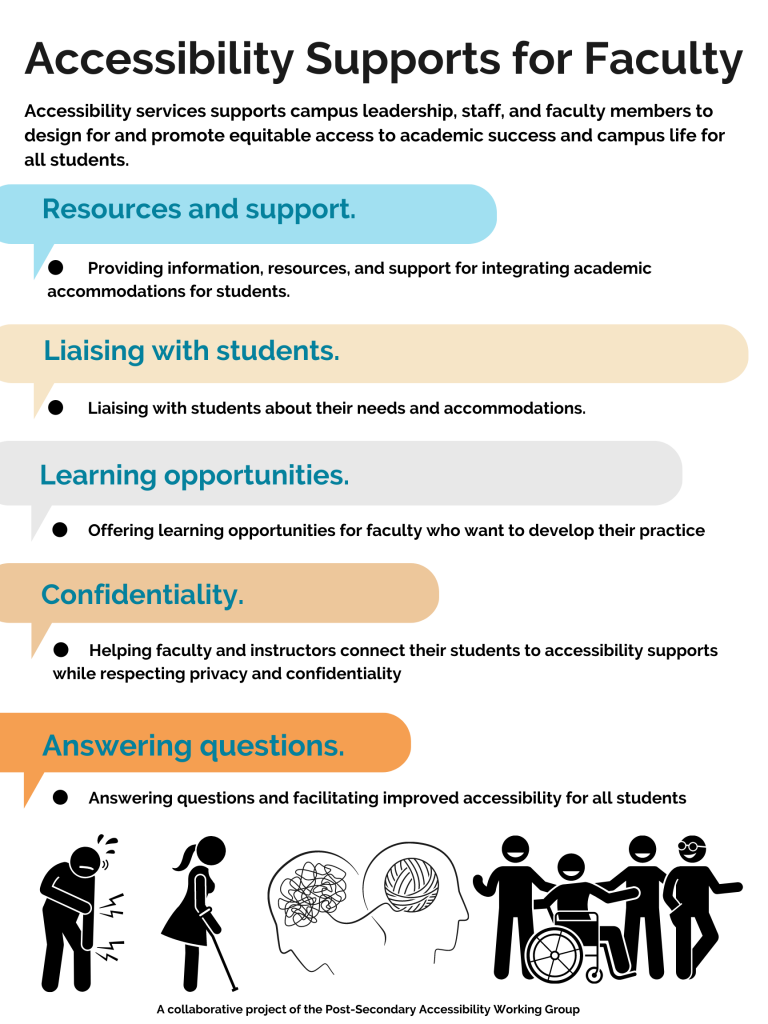4 Campus accessibility services and you
Accessibility is everyone’s responsibility, and we all need to participate in making our campuses accessible — online and in person.
Accessibility services
All institutions have an accessibility services office or staff responsible for accessibility. Accessibility services can have different names at different institutions, but their role is the same: to promote and facilitate student access, inclusion, and accommodation support. Accessibility services professionals work collaboratively with students, faculty, and staff to create an inclusive educational environment.
Accessibility centres
Accessibility centres are physical spaces that offer services for students with disabilities, and support faculty and staff to develop their knowledge and skills related to disa[bility and accessibility, as well as ways to put accommodations in place so all students can equitably participate. Most larger universities and colleges have accessibility centres, but some smaller schools may not, or may offer accessibility help in other ways.
Teaching and learning centres
Most institutions have services that support faculty development, including growing your professional practice around UDL and accessibility. Teaching and Learning Centres can support you to design, deliver, and evaluate accessible teaching strategies and learning resources, and often offer UDL training, design and development templates, and review or evaluation resources.
The role of accessibility services
A key role of accessibility services is identifying and putting in place accommodations for students who need them.
Academic accommodations:
- change how a student learns material and meets outcomes, not what material the student is learning or which outcomes or competencies they’re meeting.
- might influence or change how the student is assessed. These adjustments could be in the instructional method, environment, materials, or assessment strategy.
The purpose of accessibility services is to create equitable access for students with disabilities to the full post-secondary experience both inside and outside the classroom, both on campus and online.
Accessibility professionals do this by offering a range of services. Generally, accessibility services can support students by:
- Identifying barriers individual students are facing and addressing them
- Providing one-on-one advising to facilitate access to academic courses and programs, facilities, services, and activities
- Setting up academic accommodations and working with professors
- Assisting students with applying for funding for services and equipment
- Helping them access assistive technology to read textbooks, write papers, and study
- Connecting them with tutoring or note-taking services
- Ensuring physical access to buildings, classrooms, learning spaces, and equipment
- Advocating on behalf of and alongside them throughout their academic program, and supporting self-advocacy
- Connecting them with on- and off-campus resources to enhance their success
Accessibility services also supports campus leadership, staff, and faculty members to design for and promote equitable access to academic success and campus life for all students.

Accessibility services can support faculty, instructors, and staff in the following ways:
- Providing information, resources, and support for integrating academic accommodations for students
- Liaising with students about their needs and accommodations
- Offering learning opportunities for faculty and instructors who want to develop their practice
- Helping faculty and instructors connect their students to accessibility supports while respecting privacy and confidentiality
- Answering questions and facilitating improved accessibility for all students
Accommodations are tailored to individual students, but integrating accessibility into the design and delivery of courses can benefit all students in the classroom. For example, providing all learning materials in both print and audio formats to everyone gives students multiple ways to access the information. This is an example of Universal Design for Learning, or UDL.

Our roles and responsibilities
We all have roles and responsibilities when it comes to disabilities on campus. As a campus community, we value the diversity disability brings. Students are partners and experts in their own learning. When students identify barriers, it’s an opportunity to learn: about differences, needs, and teaching approaches.
We all have roles to play in making and keeping our schools — and all aspects of learning — accessible. We also have responsibilities, to ourselves and others.
It’s important for students with disabilities, campus leadership, faculty members, and staff to understand what they can do to eliminate barriers and improve inclusion and belonging for everyone.
Students with disabilities have the right to:
- Belong and feel like valued members of the campus community.
- Equitable access to learning, physical spaces and equipment, services, programs, activities, and campus life — both in person and online.
- Instruction, learning materials, academic experiences, assessments, and supports appropriate to their specific needs.
- Confidentiality and privacy.
Students with disabilities can:
- Identify and communicate regularly with accessibility services about their specific needs, and provide information and documentation.
- Expect equitable access to campus life, learning, and academic achievement, and advocate for themselves or with the help of accessibility services.
- Understand and work within their institution’s policies, or advocate for a change in policy.
- Talk with their professors about their learning needs, if they choose to.
Faculty members and instructors can:
- Learn about accessibility from students with disabilities.
- Adapt their teaching style to be more accessible to more students.
- Decide on course content, outcomes, and required competencies.
- Set high academic requirements for their courses.
- Consult and learn from accessibility services about accommodations and UDL options.
- Ask that any recording of classes is solely for students’ academic use.
Faculty members and instructors have the responsibility to:
- View students with disabilities as being as valuable and capable as any other student.
- Work with students and accessibility services to put accommodations in place and integrate UDL to make learning more accessible to everyone.
- Understand and work within their institution’s policies.
- Ensure course design, content, materials, instruction, labs, and field trips are accessible to all students.
- Maintain students’ dignity and privacy, and follow confidentiality rules.
Accessibility services can:
- Help individual students identify, evaluate, and re-evaluate their strengths and needs; share learning strategies and skills; and update supports.
- Review students’ documentation and let them know when updates are needed.
- Help implement accommodations and design changes that reduce barriers to learning.
Accessibility services has the responsibility to:
- Help maintain a safe environment free of discrimination, disturbance, intrusion, or harassment for all students.
- Provide expertise and resources to professors and faculty members.
- Educate the campus community about accessibility and what they can do to make campus inclusive for everyone.
What’s the difference between a UDL approach and an accommodation approach?
Integrating UDL into teaching lays the groundwork for all students to succeed. A UDL approach may eliminate the need for some academic accommodations, but there will always be students who need accommodations to meet their specific needs.
- UDL builds courses and classrooms to be accessible to the broadest range of abilities.
- Accommodations are alternative ways for individual students to access coursework, participate, meet outcomes, and demonstrate competencies.
Many students will need and benefit from BOTH approaches. In practice, courses and classrooms are most inclusive, effective, and welcoming when a combination of UDL and individual accommodations is used.
How do we determine who is eligible for accommodations?
Accessibility services professionals help students access accommodations by:
- Reviewing recommendations from a qualified assessing professional;
- Using functional evaluations and screening tools and referring students for further professional evaluation;
- Talking with students about their experiences, skills, and needs;
- Evaluating the specifics of a student’s program and courses; and
- Understanding the institutional context.
Including an accessibility statement in your course outline or syllabus
What is an accessibility statement?
An accessibility statement tells your students what they can expect in your course and classroom in terms of accessibility. It’s a written commitment to your students that you take accessibility seriously and value their contributions to an accessible environment. This statement can be included in your course outline or syllabus, and it’s also a great idea to read it out loud and discuss it with the class.
Your institution has an accessibility statement, and it’s a good idea for you to have one, too!
Who are you doing this for?
Your accessibility statement is for students who have disabilities or who might have problems accessing your resources for whatever reason. While it’s great to talk about your professional commitment to accessibility, your accessibility statement is first and foremost a helpful resource for students with disabilities. When you create your accessibility statement, always centre who will be accessing the statement and why.
What can you consider for your accessibility statement?[1]
- Use clear and simple language. Avoid jargon and technical terms.
- State your institution’s appreciation for learner variability.
- Include information about accessibility services on campus and how to access them.
- Let students know the different ways they can reach and communicate with you. Make sure there are options suitable for students who have visual, hearing, or mobility impairments.
- Tell students how they can personalize their experience of the course, including information about:
- any platforms or resources you’re using, and their built-in accessibility features.
- different browser settings that enhance accessibility
- links to each available file format your resources come in
- assistive technologies
- Outline specific accessibility features of your course and how to use them, like online textbooks or videos with closed captioning.
- Be transparent and open about accessibility barriers and describe what is being done to address them and how long it will take. Provide temporary workarounds.
- Include information about who is responsible for the accessibility of the course content and their contact information so people can submit suggestions or complaints related to accessibility.
- Refer students to your school’s accessibility policy, any guidelines you are following; any federal or provincial legislation you are conforming to, and any user testing you performed.
- Include pictures of faculty and staff members involved in the course, or link to resources that show visuals of the faculty, staff, office, or classroom if possible.
(Adapted from BCcampus Open Education Accessibility Toolkit, shared under Creative Commons License.)
Sample accessibility statement
Below is a sample accessibility statement from Dalhousie University for use by faculty.
Accessibility and Accommodations
The Advising and Access Services Centre is Dalhousie’s centre of expertise for student accessibility and accommodation. The advising team works with students who request accommodation as a result of a disability, religious obligation, or any barrier related to any other characteristic protected under Human Rights legislation (NS, NB, PEI, NFLD).
If there are aspects of the design, instruction, and/or experiences of this course that result in barriers to your inclusion, please contact the Student Accessibility Centre.
Please note that our classroom may contain accessible furniture and equipment. It is important that these items remain in the classroom, undisturbed, so that students who require their use will be able to fully participate.[2]
Confidentiality
Confidentiality refers to our obligation to keep private information secret. In this case, it means we must not disclose private or personal information about our students, their disabilities, or diagnoses.
What does confidentiality mean in practice?
- Faculty may receive a request for accommodations without knowing the student’s disability. Students may disclose their disability or not — it’s up to them.
- Violation of confidentiality can have legal impacts on both the faculty member and the institution.
- Accessibility Statement section adapted from Chapter 11 in Accessibility Toolkit, 2nd Edition, (2019). Edited by Amanda Coolidge, Sue Doner, Tara Robertson, and Josie Gray. CC BY https://opentextbc.ca/accessibilitytoolkit/chapter/accessibility-statements/ ↵
- Accessibility statement provided by Director of Facilities Management, University of King’s College. ↵
Programs, services, processes, and policies related to assistive technology, accessibility accommodations, assessment processes, communication services, transition planning, and others that ensure access to learning and learning communities.
Assistive technology is any device, software, service, or product system, including service animals, that reduces individual barriers to accessing and engaging in all aspects of a learning community including social, emotional, academic, and daily living activities and experiences.

